Archived Article Detail
By Thomas P. Moore
Need to search for a keyword, title or article on this page? On your keyboard, hold down the “Ctrl” and “F” key and a “Find in page” box will appear at the bottom of your screen. Type in your keyword and check the “Highlight All” box and like magic your keyword will appear highlighted as you scroll up and down the page!
WHAT’S NEW IN THE MINERAL WORLD ARCHIVE – posted on 12/1/2010
The big fall mineral shows are over, and the holiday season now comes on apace. If you are already into Christmas shopping, your non-mineralogical loved ones will no doubt be happy with their sweaters, ipads, bottles of grog, etc., while on Christmas day you will be in your Mineral Room happily relishing goodies you’ve bought for yourself, perhaps including (who knows?) one or two you might find right now—
On The Web
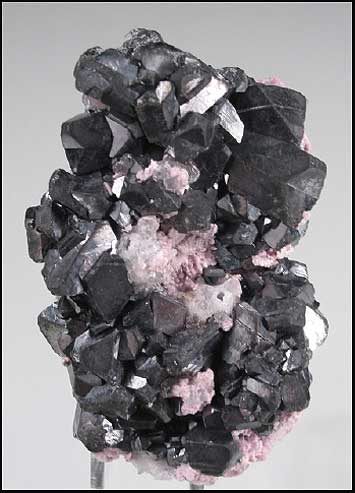
Khyber Minerals specimen and photo.
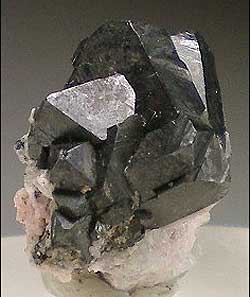
Trinity Minerals specimen; John Veevaert photo.
In his report on the 2010 Munich Show (coming up in the January-February issue), Wendell Wilson describes the new and extremely fine specimens of alabandite which were one of that show’s most notable what’s-new items. Previously almost unknown in presentable crystal specimens, the rare manganese sulfide now joins native silver, acanthite, proustite, pearceite and rhodochrosite as one of the species occurring in world-class specimens at the Uchucchacua silver mine, Oyon Province, Lima Department, Peru. In 2008, in an abandoned stope of the mine, Jaroslav Hyrsl collected a few specimens showing sharp, spinel-law-twinned, black alabandite octahedrons, and one of these harbinger specimens was sold to Bill Pinch at the 2009 Tucson Show; it is pictured with the report on that show in the May-June 2009 issue. It’s likely, though, that the 48 specimens seen in Munich in 2010 represent a later, more prolific find. The specimens were brought out by Peruvian dealer Teodicio Ramos Cabrera, and nearly all were sold to Luis Miguel Burillo, who distributed them to other collectors and dealers, especially John Veevaert who bought many of them. Among web dealerships with at least a few of the alabandites are Trinity Minerals (www.trinityminerals.com), Jordi Fabre (www.fabreminerals.com), The Webmineralshop (www.webmineralshop), and Khyber Minerals (www.khyberminerals.com). The semimetallic black, smooth-surfaced octahedral crystals and spinel-law twins of alabandite, reaching 2 cm, appear as loose singles and isolated clusters, and as color-contrasting matrix pieces of white calcite and pale pink rhodochrosite strewn generously with alabandite. According to John Veevaert, some of the specimens also show traces of what may be a new manganese-silver sulfosalt. Shown here are a thumbnail and a cabinet specimen of this interesting material…I note however that almost all of the alabandite specimens offered by John Veevaert on his Trinity Minerals site are now marked there as “sold”–just a few days after making their online debut.
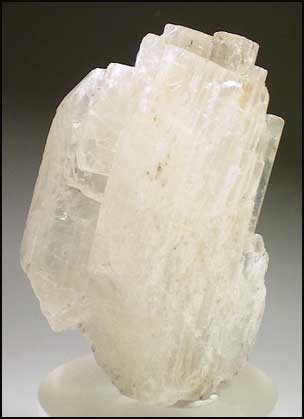
Hambergite, 5.7 cm, from the Tampo’ny ilapa vein, Sahatany Valley, Antananarivo,
Madagascar. Trinity Minerals specimen; John Veevaert photo.
Don’t stop browsing yet in the “Munich Show” section of the Trinity Minerals website, though, for there John Veevaert also shows ten loose compound crystals of milky white to colorless hambergite from a new find in what is called the Tampo’ny ilapa vein, Sahatany Valley, Antananarivo Province, Madagascar. Ranging in size from 1.5 to 5.7 cm, the hambergite crystals are sharp, lustrous, well terminated and (in general) quite fine for representatives of the species. And while you’re on John Veevaert’s cyberturf, I would recommend that you visit his “European Room,” where you’ll find no less than 12 good thumbnail and miniature-size silver specimens from Kongsberg, Buskerud, Norway. For some 350 years the best among all the world’s sources of fine specimens of wire silver, Kongsberg finally closed for good in 1957. But in the years since then, local collectors have been chiseling out some interesting things from the old workings of the area’s 300 or so separate silver mines; presumably John’s specimens, which hail from the Gottes Hulfe in der Noth (“God’s Help in Distress”) mine, are of fairly recent vintage. They are irregularly shaped but highly lustrous aggregates of silver dendrites, leaves and small wires set on massive white calcite with massive acanthite, and some are darkened by coatings of tiny pyrargyrite and acanthite crystals.
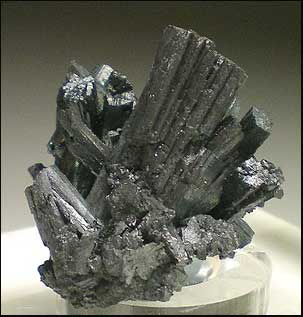
Thuringia, Germany. Trinity Minerals specimen; John Veevaert photo.
In our November-December 2010 issue you’ll read (or by now have read) all about the famous old Ilfeld, Thuringia, Germany locality for what are still the world’s finest specimens of crystallized manganite. Although the Ilfeld mines closed in 1922, there have been some recent finds of manganite and fine hausmannite pseudomorphs after manganite on the old dumps—and so I can’t resist mentioning here that two splendid specimens of pseudomorphous hausmannite are also offered in John Veevaert’s “European Room.” The larger specimen, shown here, measures 3.4 cm, displays the manganite crystal form extremely well, and is probably from a group of such specimens that were dug on the dumps in 2008. Achtung! pseudomorph devotees.
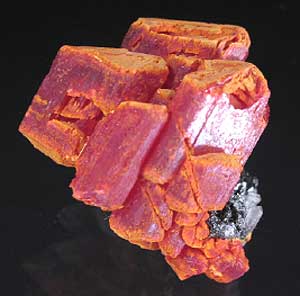
Department, Peru. Khyber Minerals specimen and photo.
Besides the big alabandite specimen shown above, there is the usual abundance of interesting items on the site of Khyber Minerals (www.khyberminerals.com), among them a new lot of ten specimens, thumbnail to small-cabinet size, of realgar from the Palomo mine, Huachocolpa district, Huancavelica Department, Peru (see Jaroslav Hyršl’s article on this locality in March-April 2008). Complex, sharp, blocky red realgar crystals to 2 cm, most of them with thin fringes of yellow orpiment, cluster in loose groups and on druses of quartz crystals with associated galena and sphalerite crystals. Some of the specimens show small areas sprinkled with microcrystals of the Pb-Cu sulfosalt seligmannite.
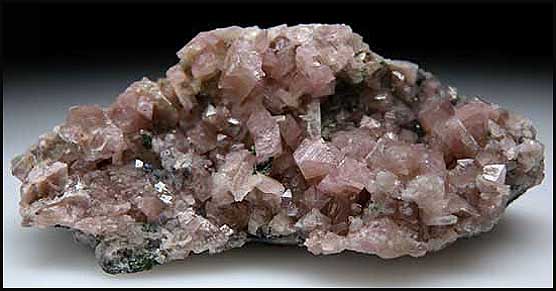
Marin Minerals specimen and photo.
In my published report (September-October 2010 issue) on Dave Waisman’s new San Francisco Fine Minerals Show, I noted some ongoing field work by Clive Matson and his eager son (whom I insulted in print by guessing his age as 10; in fact, I’ve been duly admonished, he is 13)—who lately have been digging excellent specimens of the rare Ca-Al silicate lawsonite from an undisclosed site in Mendocino County, California. At the San Francisco show in July, about 20 miniature and small-cabinet-size specimens of the material were with the Matsons in the room of Cascade Scepters, but supplies since then have been cornered by Mike Keim of Marin Minerals (www.marinmineral.com), on which site you may now see 31 freshly dug lawsonite specimens. They are even more impressive than the biggest and best that were on hand in San Francisco: matrix plates ranging from 4 to 11 cm across are densely covered with lawsonite crystals to more than 1 cm individually. The very sharp crystals are vaguely diamond-shaped, pale pink to pinkish orange, and mostly opaque, though a few are translucent in part. Specimens are prepared by dissolving away the calcite which fills thin seams, exposing gleaming pink crystal carpets on greenish gray glaucophane schist (this tough rock has been saw-cut along the bottoms of most of the matrix plates). A much earlier lawsonite find, in Marin County in the 1950s, cannot compete: these are surely the best lawsonite specimens in the world, and Mike’s prices for them remain quite reasonably in the high-two to low-three-figure range.

Arkenstone specimen; Joe Budd photo.
An October 15 update to the site of Rob Lavinsky’s The Arkenstone (www.irocks.com) offers 15 loose, prismatic crystals, about half of them doubly terminated, of beautiful bicolored beryl from Padre Paraiso, Minas Gerais, Brazil. For the most part the bright, gemmy crystals are pale yellow heliodor, but they are distinguished by pale aquamarine-colored zones near the terminations. Also they are distinguished by size: most are over 12 cm long, and the longest (shown here) measures 26.7 cm. Rob testifies that the huge crystal is unrepaired—a miracle of survival out of the small pocket which yielded these lovely prizes sometime in summer 2010. But if your Christmas stocking is on the short side, stouter gemmy crystals to around 4 cm long are also among the selection.
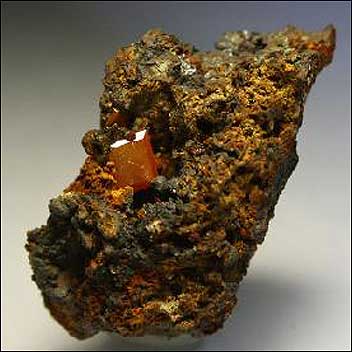
Wulfenite, 7 mm crystal on 4.7-cm matrix, from Laurium, Attika, Greece.
Greekrocks specimen and photo.
The online dealership Greekrocks (www.greekrocks.com) was founded in 2009 by Christos Spiromitros, and this is not the first time I’ve mentioned the diversity of very interesting Greek minerals, both old and contemporary, to be found there. A recent update offers good specimens of pyrite, boulangerite and rhodochrosite from the long-defunct mining region around Stratoni, Chalcidiki, in northern Greece; there are also more recent specimens of ilvaite, andradite and green quartz from the island of Seriphos; surprisingly good epidote crystal groups from Kimmeria, Thrace; and, of course, much from the ancient (and modern—to about 1975) mine tunnels at Laurium, Attika. Laurium specimens offered include barite, fluorite, annabergite, picropharmacolite and more—you have probably seen their likes, but have you ever seen a good specimen of wulfenite from the Laurium mines? Well, here is a bright orange tab, sharp as you’d wish, 7 mm on edge, resting in the center of a gossany 4.7-cm matrix. Other finds as nifty as this await the visitor to Greekrocks.
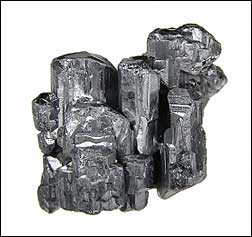
Mineral Classics specimen and photo.
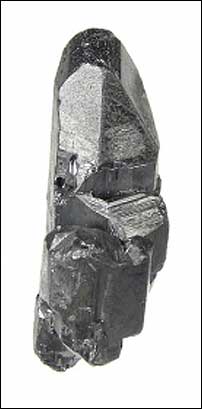
Mineral Classics specimen and photo.
Everyone needs (as everyone knows) a fine stephanite, but prices typically charged for rarely appearing old-timers from Freiberg, Príbram, or even Fresnillo hardly bear thinking about—to the rescue come the superb new thumbnails from the Porco mine, Potosí, Bolivia. Yes, you’ve recently heard something like this pitch from me, for excellent thumbnails of Porco mine stephanite began to trickle out late last year, and I’ve mentioned them in my reports from this year’s Tucson and Denver shows and in my last online column. But now, on the site of Brian and Brett Kosnar’s Mineral Classics (www.minclassics.com), 17 thumbnails appear which Brian has just finished cleaning up, photographing and pricing (for $150 to $900—still not cheap for thumbnails, but quite a fair range for the quality we are talking about). Brilliantly lustrous metallic gray, columnar, well terminated, slightly distorted and pitted stephanite crystals to more than 2.5 cm form parallel groups without matrix or associations. Even Freiberg seldom did better than this, and I recommend highly that Santa just suck it up and buy one; they’re already going fast on the site, and future supplies, of course, cannot be guaranteed. Brian Kosnar told me in Denver that these specimens—which at that time looked just a bit scruffy—would “clean up well,” and the two pictured here show that they certainly did.
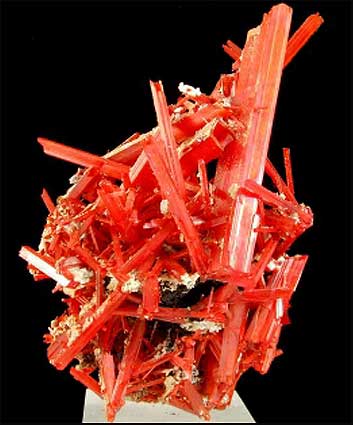
Spirifer specimen and photo.
Adventurers from the Polish mineral syndicate Spirifer (www.spiriferminerals.com) have been off on their travels again, and earlier this year they were the first foreign visitors on the scene after a big new crocoite pocket in the Adelaide mine, Dundas district, Tasmania, Australia, had been hit. The pocket was two meters long and was to take Adam Wright’s Adelaide Mining Company more than two months to clean out. About 350 significant specimens were produced (not counting loose single crystals found in the pocket detritus), and the crocoite prisms reach 14 cm long. Besides a mini-article on the find, the Spirifer website now offers about a dozen specimens from it, thumbnail to small-cabinet size, with sleek, mostly well terminated, crocoite crystals ranging in color from bright orange to deep red.
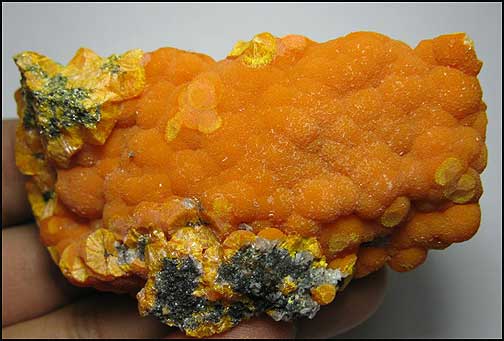
JinMing Mineral Company specimen and photo.
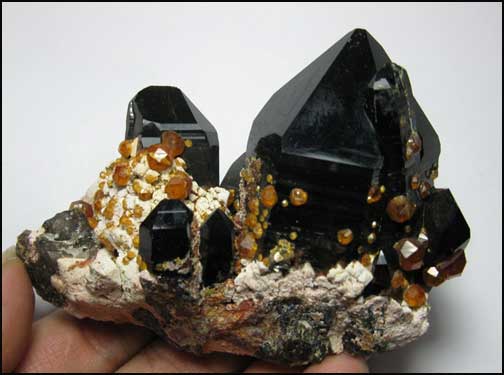
JinMing Mineral Company specimen and photo.
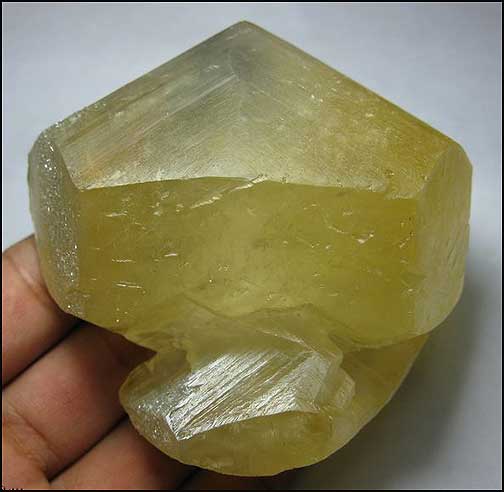
JinMing Mineral Company specimen and photo.
Since my last online report the new, China-based, JinMing Mineral Company website (www.jmineral.com) has been expanded notably—although it still has almost no text and is rather confusingly organized. Among its very recent updates are good-looking specimens of botryoidal orpiment from “Shimen” (presumably the Shimen arsenic mine, Shimen, Hangde Prefecture, Hunan Province); a few great-looking smoky quartz groups bestrewn with little spessartine crystals, from Tongbei, Fujian Province; and handsome calcite specimens from “Lengshuijiang, Loudi, Hunan.” Liu’s Fine Minerals of China (2006) shows Lengshuijiang as the name of a town just a few kilometers south of the great Xikuangshan antimony mine, one of China’s great stibnite localities and one of the world’s largest antimony deposits; the mine has also produced yellow-orange, translucent to transparent, short-prismatic crystals of calcite, as in the pretty specimens on the JinMing site.
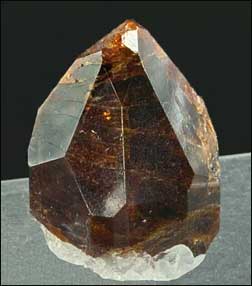
Pala Minerals specimen and photo.
Bill Larson’s Pala International Company has long had an extensive website whereon Bill’s activities in the international gem trade have been documented, with subordinate, rather skimpy pages devoted to mineral specimens. Now, though, there is a separate website, Pala Minerals (www.palaminerals.com) exclusively for mineral-shoppers, and 51 fine specimens are offered on it at present. Most of these are gem crystals (heavy on beautiful elbaites) which are not for the budget shopper, but Bill likes old classics too, and he appreciates thumbnails (yay!), and so in the middle of page 3 one finds a 2.5-cm, sharp, lustrous, nearly complete brown crystal of uvite-dravite (labeled “tourmaline”) from Gouverneur, St. Lawrence County, New York, priced at $250 and, I think, a bargain at that. This site is worth everyone’s trouble to monitor in the future; among its other pages are The Classics, The Vault, The Bargain Bin (specimens under $500), Articles, and Your And My Want Lists.
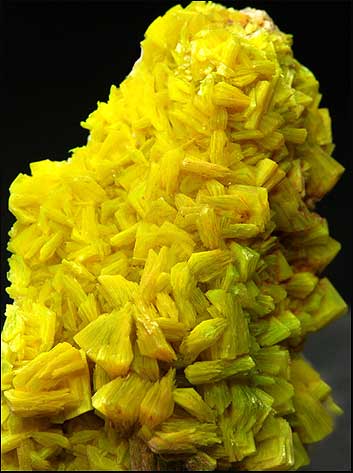
Athos Locatelli’s Minservice site (www.minservice.com) compiles recent updates from several Italian dealerships, and poking around in its myriad pages can bring on a “Mediterranean” sense of time, or of time-loss, i.e. one can browse for uncounted hours, as if during siesta-time on a sunny subtropical strand, and in the process one can learn a great deal about interesting mineral finds in out-of-the-way Italian (and other) places. For instance, crusts of typically bright yellow-green sheaves of autunite crystals were once found in old mines around the town of Peveragno, just southeast of Cuneo in western Piedmont: an old reference tells me this, but I’d never before seen a specimen. The one now on view on the Minservice site (see the picture above) is quite up to the standards set by the well-known autunites of Washington, Brazil, Portugal and Germany. The specimen belonged to Ferrero’s Minerals—one of the dealerships represented on Minservice—and is, I regret to say, already marked “sold.”
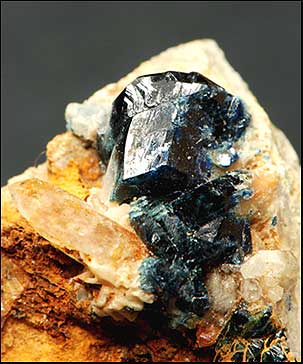
Potosí, Bolivia. Minservice specimen and photo.
Or consider this sharp, flashing blue, 6-mm crystal of the very rare species scorzalite on matrix, representing a recent discovery of the world’s finest scorzalite crystals in the Estaño Orcko mine, Machacamarca district, Potosí, Bolivia. This one is not yet sold (it costs 55 Euros), and you may see it on the Cultminerals subsite of Minservice.

ItalianMinerals.com specimen and photo.
Along the same lines, another Italian site, quite sensibly named ItalianMinerals.com, has an October 24 update wherein it offers three fine miniatures of pyromorphite from Crabulatzu, Fluminimaggiore, Sardinia—where mining began in the 6th century B.C., during settlement by the Phoenicians, and ended in the early 1960s. Cauliflowerform bundles of bright yellow-green pyromorphite crystals are scattered all over pale brown matrix of what appears to be iron-stained cellular quartz.
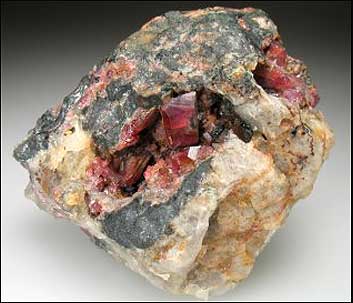
Bavaria, Germany. Crystal Classics specimen and photo.
And as long as I’m finishing up this report with old European items of note, check out (below) the German classic that Ian Bruce of Crystal Classics (www.crystalclassics.co.uk) picked up at the Munich Show. It is a specimen of phosphosiderite from Kreuzberg, Pleystein, Bavaria, with a transparent red, blocky, 1-cm crystal of phosphosiderite, representing the best occurrence of this species (and of the related phosphate strengite) ever found in the world. The Kreuzberg, a steep promontory (with a church on top) which rises above the village of Pleystein, is mostly composed of the former quartz core of a largely weathered-away, phosphate-rich pegmatite. At 10:00 P.M. on March 6, 1960, a 100-ton quartz boulder tumbled down the cliffside, destroying a small shed enroute and hitting the outside wall of a movie theater. Panicked townspeople who’d just taken in the movie rushed out into the street, but inquisitive mineralogists, later, were better pleased: seams and vugs in the boulder proved to contain phosphosiderite crystals to 5 cm, and gemmy purple strengite crystals to 1 cm, as well as microcrystals of other rare phosphates. The Kreuzberg now is under protection as part of a nature preserve, and collecting there has long since ceased, but if you like this shard of History you might even pay Ian the $1500 he asks, and get to keep it.
Old Mining On Your Wall
This heading is the title of a press release put out by MOXXO Design, Enzmannstrasse 4, 09112 Chemnitz, Germany, to promote its new product, a classy-looking 2011 calendar, eighteenth in a series of “Original Saxon Mining” calendars. This newest effort is called “Traditionals of Saxon Mining 2011,” and never mind the not-quite-traditional English; if you like mining history you’ll probably relish the pages of this calendar, whose special topic is the musical folk culture associated with mining in the Saxon Ore Mountains (Erzgebirge). The calendar offers “exclusive archive photos” and “lyrics and traditionals from the Saxon mining industry’s oral culture.” The press release explains the word on the cover page as follows: “In German terminology, the word ‘Bergreyhen’ is [an] umbrella term for the more than 500-year-old musical culture of the Saxon Ore Mountains. A Saxon miners’ rite of the early 16th century, for example, asked every shift’s foreman to find other workers to be singers for the respective shift. A first ‘Mining Singers Order’ ruled the musical accompaniment of this cultural asset during the 17th century. Traditionally these songs address topics such as a miner’s professional pride but also [the] dangers and burdens of the mining work…” A second available 2011 calendar is called “Mining Motives [motifs?] on German Emergency Money 2011″—showing the mining scenes sometimes printed on the Notgeld bills issued during Germany’s calamitous period of inflation in the early 1920s. Both calendars may be ordered (the press release does not give their prices) through www.bergbaukalender.de.
Here’s wishing everyone a happy holiday season!
For questions about this column, please email Tom Moore.
